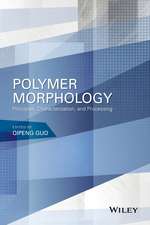Macromolecular Concept and Strategy for Humanity in Science, Technology and Industry
Editat de Seizo Okamura Contribuţii de Y. Ito Editat de Bengt Ranby Contribuţii de S. Kawabata Editat de Yoshikazu Ito Contribuţii de M. Niwa, S. Okamura, B RANBY, Y. Sakurada, K. Takakura, N. Yodaen Limba Engleză Paperback – 18 sep 2011
Preț: 381.98 lei
Nou
Puncte Express: 573
Preț estimativ în valută:
73.09€ • 76.51$ • 60.84£
73.09€ • 76.51$ • 60.84£
Carte tipărită la comandă
Livrare economică 31 martie-14 aprilie
Preluare comenzi: 021 569.72.76
Specificații
ISBN-13: 9783642646652
ISBN-10: 3642646654
Pagini: 188
Ilustrații: XII, 184 p.
Dimensiuni: 155 x 235 x 10 mm
Greutate: 0.27 kg
Ediția:Softcover reprint of the original 1st ed. 1996
Editura: Springer Berlin, Heidelberg
Colecția Springer
Locul publicării:Berlin, Heidelberg, Germany
ISBN-10: 3642646654
Pagini: 188
Ilustrații: XII, 184 p.
Dimensiuni: 155 x 235 x 10 mm
Greutate: 0.27 kg
Ediția:Softcover reprint of the original 1st ed. 1996
Editura: Springer Berlin, Heidelberg
Colecția Springer
Locul publicării:Berlin, Heidelberg, Germany
Public țintă
Professional/practitionerCuprins
1 Introduction.- 2 The Concept of Macromolecules - Emergence, Development and Acceptance.- 2.1 Introduction.- 2.2 The Early Polymer Industry.- 2.3 Early Studies of the Molecular Structure of Native Substances.- 2.4 The Macromolecular Concept.- 2.5 References.- 3 Polymers — A Growing Science.- 3.1 Introduction.- 3.2 Polymerization.- 3.3 The Molecular Weight (Mass) of Macromolecules.- 3.4 The Physical Chemistry of Polymers.- 3.5 The Properties of Polymeric Materials.- 3.6 Analysis of Polymer Chain Structure.- 3.7 Liquid Crystal Polymers (LCP).- 3.8 Electrically Conducting Polymers (ECP).- 3.9 Conclusions.- 3.10 References.- 4 A New Trend in Polymer Science and Technology for Humanity.- 4.1 Introduction.- 4.2 Property of Polymeric Materials as the Primary Performance.- 4.3 Functionality as the Secondary Performance.- 4.4 Sensitivity as the Tertiary and Final Stage.- 4.5 Functionality (Front Side) and Sensitivity (Back Side) in the Fusion of Technique and Arts.- 4.6 References.- 5 Plastics and Rubber.- 5.1 Developments Before 1950 — The First Generation of Plastics.- 5.2 Construction Plastic Materials — The Second Generation of Plastics.- 5.3 Specialty Polymeric Materials — The Third Generation of Plastics.- 5.4 Electrically Conducting Polymers.- 5.5 Liquid Crystal Polymers (LCP) and Other Specialty Polymers.- 5.6 Elastomers.- 5.7 The World-Wide Polymer Industry.- 5.8 References.- 6 Recent Progress of Fiber Technology and Applications - the Creation of New Values -.- 6.1 Overall Reviews.- 6.2 Technological Innovation of New Fibers (Shingosen).- 6.3 New Synthetic Fibers for Apparel Applications.- 6.4 High Performance Fibers and Advanced Composite Materials.- 6.5 Plastic Optical Fibers for the Communication Industry.- 6.6 Management of the Fiber Industry in the Age ofHigh Technology.- 6.7 References.- 7 Recent Progress in the Objective Measurement of Fabric Hand.- 7.1 Introduction.- 7.2 Hand Judgement for the Evaluation of Fabric Character and Quality.- 7.3 Primary Hand and Total Hand.- 7.4 Objective Evaluation of Fabric Hand.- 7.5 Developments in the Application of Objective Evaluation.- 7.6 Conclusions.- 7.7 References.- 8 Impact of Medical Technology Utilizing Macromolecules on Society.- 8.1 Overview.- 8.2 Application of Hollow Fiber Membrane Made from Various Macromolecules to Blood Purification Devices.- 8.3 Impact of Dental Polymeric Adhesives on Dental Materials and Dentistry.- 8.4 References.- 9 Agendas for Research Cooperation in the Japanese Chemical and Materials Industry.- 9.1 Abstract.- 9.2 Industrial Trends and Restructuring in the Japanese Chemical and Materials Industry.- 9.3 Public and Private Cooperation in R & D Activities for Innovative Future Technology.- 9.4 Research in Developed Countries.- 9.5 New Advanced Materials.- 9.6 Setting Research Agendas and Organization of the Public and Private Sectors.- 9.7 Prospects for the Chemical Industry in a New Chemical Age.- 9.8 Conclusion.- 9.9 International Competition and Cooperation.- 9.10 References.- 10 Management Strategy for R & D and Industrial Policy.- 10.1 Introduction.- 10.2 Global Management Strategy Survey Mission in 1979,1984, and 1988.- 10.3 Examples of Collaborative Industrial Research.- 10.4 R & D is Essential for Business Success.- 10.5 Economic Symbiosis: Building New World Order and Concepts Used to Build Japanese Pagodas.- 10.6 Conclusion.- 10.7 References.- 11 Polymers as the Basis of Human Body and Mind.- 11.1 Introduction.- 11.2 Knowledge and Wisdom.- 11.3 Importance of the Fusion of Concepts.- 11.4 Physical Science as Body and Psychological Science as Mind.- 11.5 Human Spirit Through Macromolecular Conception.- 11.6 References.
Textul de pe ultima copertă
New macromolecular concepts and strategies are demonstrated in this unique book. It deals with the harmonization of humanity in science, technology and industry. Particular attention is given to the relationship between the sensitivity of the human mind and the functionality of polymers such as "Shingosen". Moreover, biocompatibility of functional polymers for medical applications and fabrics is discussed as one of the prime examples of human creativity. Lessons of conventional wisdom of traditional Japanese shrine carpenters, which originated 1300 years ago in Horyuji Temple in Nara Japan, can be applied to the modern business management by entrepreneurs and in high-tech industries. For scientists and professionals in polymer and material sciences as well as history of chemistry.












